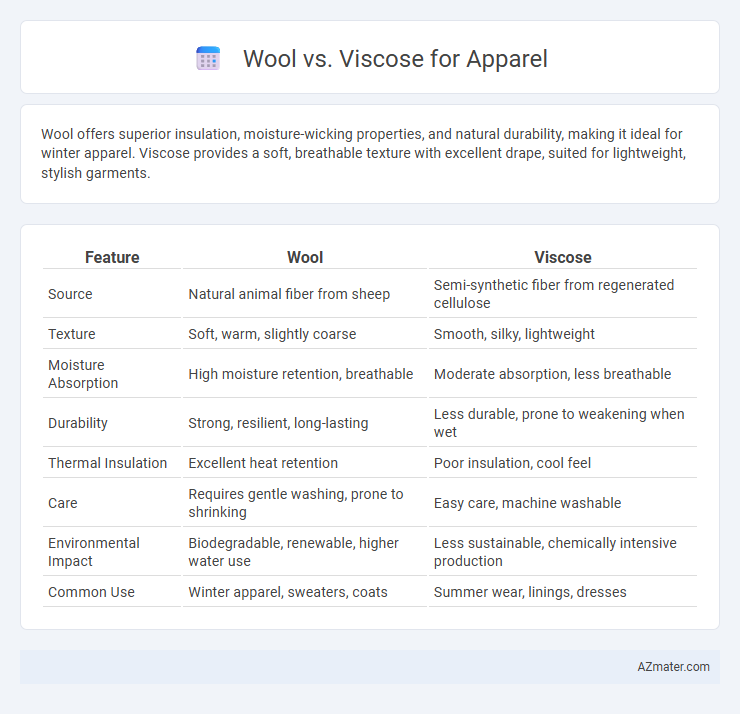Wool offers superior insulation, moisture-wicking properties, and natural durability, making it ideal for winter apparel. Viscose provides a soft, breathable texture with excellent drape, suited for lightweight, stylish garments.
Table of Comparison
| Feature | Wool | Viscose |
|---|---|---|
| Source | Natural animal fiber from sheep | Semi-synthetic fiber from regenerated cellulose |
| Texture | Soft, warm, slightly coarse | Smooth, silky, lightweight |
| Moisture Absorption | High moisture retention, breathable | Moderate absorption, less breathable |
| Durability | Strong, resilient, long-lasting | Less durable, prone to weakening when wet |
| Thermal Insulation | Excellent heat retention | Poor insulation, cool feel |
| Care | Requires gentle washing, prone to shrinking | Easy care, machine washable |
| Environmental Impact | Biodegradable, renewable, higher water use | Less sustainable, chemically intensive production |
| Common Use | Winter apparel, sweaters, coats | Summer wear, linings, dresses |
Introduction to Wool and Viscose
Wool, a natural fiber obtained from sheep, is renowned for its excellent insulation, moisture-wicking properties, and durability, making it ideal for cold-weather apparel. Viscose, a semi-synthetic fiber derived from cellulose, offers a soft, breathable texture with a silky appearance, commonly used for lightweight garments and drapes. Understanding the distinct characteristics of wool and viscose helps in selecting the best fabric based on warmth, comfort, and garment functionality.
Origin and Production Processes
Wool is a natural fiber obtained from the fleece of sheep, primarily harvested through shearing and cleaned via scouring, preserving its protein-based structure. Viscose is a semi-synthetic fiber derived from cellulose extracted from wood pulp, which undergoes chemical treatments like carbon disulfide and caustic soda to transform into rayon fibers. The production of wool involves animal farming and natural fiber processing, while viscose production relies on industrial chemical processes to create regenerated cellulose textiles.
Texture and Feel Against Skin
Wool offers a natural, textured feel that provides warmth and breathability, making it ideal for cold-weather apparel, though some varieties can feel slightly coarse against sensitive skin. Viscose, a semi-synthetic fiber made from cellulose, has a smooth, silky texture that feels soft and cool on the skin, enhancing comfort for lightweight garments and layering pieces. Both fibers balance comfort and performance differently, with wool excelling in insulation and viscose delivering a lightweight, gentle touch.
Breathability and Moisture Management
Wool offers superior breathability and moisture management by naturally wicking sweat away from the skin and allowing air circulation, which helps regulate body temperature in both warm and cold conditions. Viscose, though smooth and lightweight, tends to retain moisture and lacks the same breathable structure, making it less effective at moisture evaporation and potentially causing discomfort during prolonged wear. For apparel prioritizing moisture control and ventilation, wool remains the optimal choice due to its natural fibers and inherent performance qualities.
Durability and Lifespan
Wool offers superior durability and a longer lifespan compared to viscose, as its natural fibers resist wear and maintain structure even with frequent use. Viscose, made from regenerated cellulose, tends to weaken and degrade faster due to moisture sensitivity and lower tensile strength. Choosing wool for apparel ensures extended garment longevity and better resistance to pilling and stretching.
Sustainability and Environmental Impact
Wool, a natural and biodegradable fiber, offers superior sustainability due to its renewable source and lower environmental footprint compared to viscose, which relies on chemically-intensive production processes and often contributes to deforestation. The carbon sequestration abilities of sheep grazing, combined with wool's durability and biodegradability, enhance its eco-friendly profile, whereas viscose production involves significant water consumption and hazardous chemical use that can lead to pollution. Choosing wool over viscose for apparel supports reduced greenhouse gas emissions and promotes circular economy principles in textile manufacturing.
Care and Maintenance Requirements
Wool requires gentle hand washing or dry cleaning to maintain its natural fibers, with careful drying flat to prevent shrinking or distortion. Viscose demands delicate machine washing or hand washing in cold water and should be air-dried to avoid weakening the cellulose fibers and losing shape. Both fabrics benefit from minimal agitation and avoiding high heat in drying to preserve garment longevity.
Cost Comparison and Affordability
Wool generally commands a higher price point than viscose due to its natural fiber source, durability, and insulating properties, making it less affordable for budget-conscious consumers. Viscose, a semi-synthetic fiber derived from wood pulp, offers a cost-effective alternative with a softer texture and good breathability, appealing to those seeking fashionable yet affordable apparel. Cost comparison shows viscose apparel often fits mid-range budgets, while wool garments are positioned in premium markets reflecting their quality and longevity.
Best Uses for Wool Apparel
Wool apparel excels in cold-weather clothing due to its superior insulation, moisture-wicking properties, and natural breathability, making it ideal for sweaters, coats, and thermal wear. Its durability and resistance to odors enhance its suitability for outdoor and activewear, while fine wool varieties like merino are perfect for lightweight, soft garments worn close to the skin. Wool's ability to regulate temperature and maintain warmth even when damp positions it as the best choice for winter apparel and performance clothing.
Ideal Applications of Viscose in Fashion
Viscose excels in fashion applications that require lightweight, breathable fabrics with a silky texture, making it ideal for blouses, dresses, and linings. Its moisture-absorbing properties enhance comfort in warm climates while maintaining a smooth drape that complements fluid designs. Compared to wool, viscose offers greater versatility for creating vibrant colors and intricate prints often favored in trendy, casual, and formal apparel.

Infographic: Wool vs Viscose for Apparel
 azmater.com
azmater.com